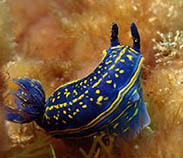Felimare picta (Philippi, 1836)
Florida regal doris
Classification / Names Common names | Synonyms | CoL | ITIS | WoRMS
Gastropoda | Nudibranchia | Chromodorididae
Environment: milieu / climate zone / depth range / distribution range Ecology
Benthic; depth range 0 - 55 m (Ref. 3446). Tropical; 19°C - 28°C (Ref. 115969), preferred 27°C (Ref. 115969); 61°N - 9°S, 93°W - 29°E
Distribution Countries | FAO areas | Ecosystems | Occurrences | Introductions
Atlantic Ocean and the Mediterranean Sea: from southern Davis Strait to Brazil, and east to Turkey.
Length at first maturity / Size / Weight / Age
Maturity: Lm ? range ? - ? cm Max length : 6.4 cm TL male/unsexed; (Ref. 3446)
Minimum depth from Ref. 109264. Lives on rocky substrate (Ref. 126121). Known from seamounts and knolls (Ref. 3477). Feeds on different species of sponges belonging to genus Ircinia, Crella, and Dysidea (Ref. 126121).
Life cycle and mating behavior Maturity | Reproduction | Spawning | Eggs | Fecundity | Larvae
Members of the order Nudibranchia are simultaneous hermaphrodites. Mating behavior: Both individuals darts their penis toward each other to induce one to act as a male and the other as the female. The victorious one to penetrate the body wall is the dominant male. Life cycle: Eggs are deposited on a substratum where they develop and hatch into (planktonic) vestigial veliger larval stage and further grow as adults.
Main reference
References | Coordinator | Collaborators
Rosenberg, G. 2005. (Ref. 3446)
IUCN Red List Status (Ref. 130435)
CITES status (Ref. 108899)
Not Evaluated
CMS (Ref. 116361)
Not Evaluated
Threat to humans
Human uses
Fisheries: commercial
| FishSource |
Tools
More information
Age/Size
Growth
Length-weight
Length-length
Morphology
Larvae
Abundance
Growth
Length-weight
Length-length
Morphology
Larvae
Abundance
Internet sources
BHL | BOLD Systems | CISTI | DiscoverLife | FAO(Publication : search) | Fishipedia | GenBank (genome, nucleotide) | GloBI | Gomexsi | Google Books | Google Scholar | Google | PubMed | Tree of Life | Wikipedia (Go, Search) | Zoological Record
Estimates based on models
Preferred temperature
(Ref. 115969): 18.8 - 28, mean 26.5 (based on 262 cells).
Price category
(Ref. 80766):
Unknown.



